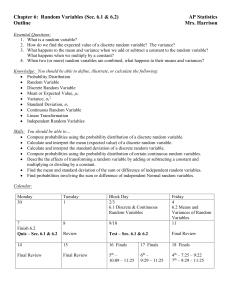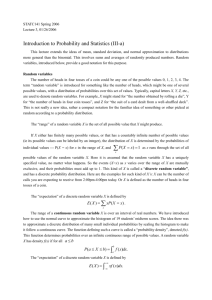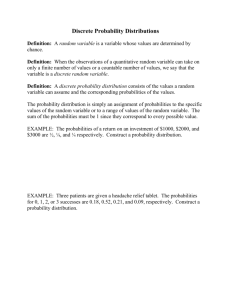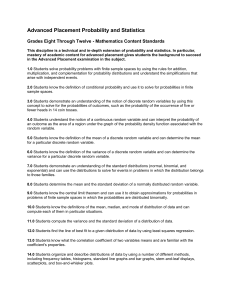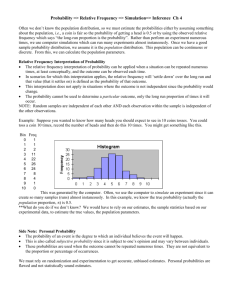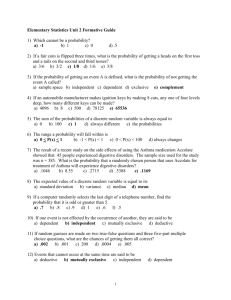MDM4U Probability Distributions
advertisement
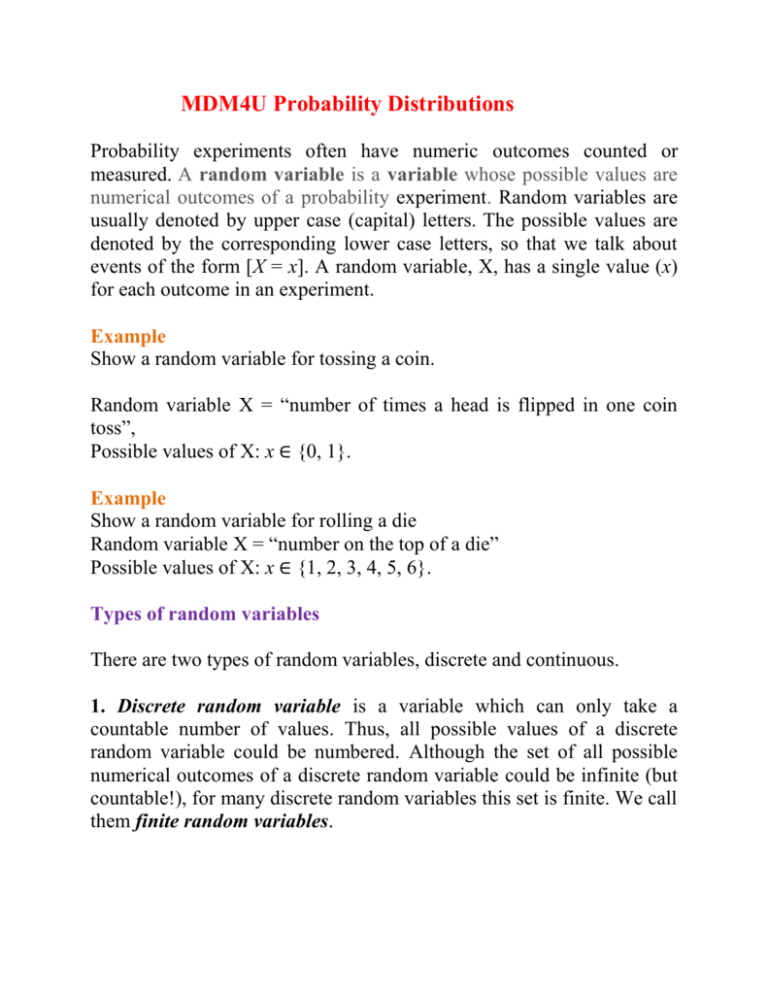
MDM4U Probability Distributions
Probability experiments often have numeric outcomes counted or
measured. A random variable is a variable whose possible values are
numerical outcomes of a probability experiment. Random variables are
usually denoted by upper case (capital) letters. The possible values are
denoted by the corresponding lower case letters, so that we talk about
events of the form [X = x]. A random variable, X, has a single value (x)
for each outcome in an experiment.
Example
Show a random variable for tossing a coin.
Random variable X = “number of times a head is flipped in one coin
toss”,
Possible values of X: x ∈ {0, 1}.
Example
Show a random variable for rolling a die
Random variable X = “number on the top of a die”
Possible values of X: x ∈ {1, 2, 3, 4, 5, 6}.
Types of random variables
There are two types of random variables, discrete and continuous.
1. Discrete random variable is a variable which can only take a
countable number of values. Thus, all possible values of a discrete
random variable could be numbered. Although the set of all possible
numerical outcomes of a discrete random variable could be infinite (but
countable!), for many discrete random variables this set is finite. We call
them finite random variables.
2. Continuous random variable can get all real values from some
interval on the number line. The set of all possible numerical values of a
continuous random variable cannot be numbered.
Example
Classify the following random variables as discrete or continuous.
1. Length of time you stay in a class.
2. Number of classes you attend in a day.
Random variables are described by their probabilities. For a discrete
random variable, its probability distribution gives each possible value
and the probability of that value:
x
𝑃[𝑋 = 𝑥]
𝑥1
𝑝1
𝑥2
𝑝2
𝑥3
𝑝3
…
…
𝑥𝑛
𝑝𝑛
Example
Probability distribution for number of tattoos each student has in a
population of students
Tattoos
Probability
𝑃[𝑋 = 𝑥]
0
0.850
1
0.120
2
0.015
3
0.010
4
0.005
Note: The total of all probabilities across the distribution must be 1, and
each individual probability must be between 0 and 1, inclusive:
0.850 + 0.120 + 0.015 + 0.010 + 0.005 = 1.
The notation P(x) is often used for 𝑃[𝑋 = 𝑥]. In this example, 𝑃(4) =
𝑃[𝑋 = 4] = 0.005.
Example
Probability distribution for number of heads in 4 flips of a coin
Heads
Probability
0
1
16
1 4
1
𝑃(0) = ( ) =
2
16
4
1
4 1
𝑃(1) = ( ) ( ) = 4 ∙
=
1 2
16
4
1
4 1
(
)
𝑃 2 = ( )( ) = 6 ∙
=
2 2
16
4
1
4 1
𝑃(3) = ( ) ( ) = 4 ∙
=
3 2
16
1 4
1
𝑃(4) = ( ) =
2
16
1 1 3 1 1
+ + + +
=1
16 4 8 4 16
1
1
4
2
3
8
3
1
4
4
1
16
1
4
3
8
1
4
The cumulative probabilities are given as
The interpretation is that F(x) is the probability that X will take a value
less than or equal to x. The function F is called the cumulative
distribution function (CDF).
For example, consider random variable X with probabilities
x
𝑃(𝑥)
0
0.05
1
0.10
2
0.20
3
0.40
4
0.15
5
0.10
For our example,
𝐹 (3) = 𝑃[𝑋 ≤ 3] = 𝑃(0) + 𝑃(1) + 𝑃(2) + 𝑃(3)
= 0.05 + 0.10 + 0.20 + 0.40 = 0.75.
One can of course list all the values of the CDF easily by taking
cumulative sums:
x
𝑃(𝑥)
F(x)
0
0.05
0.05
1
0.10
0.15
2
0.20
0.35
3
0.40
0.75
4
0.15
0.90
5
0.10
1.00
The values of F increase.
Expected Value is the average of the outcomes. The expected value of X
is denoted either as E(X) or as μ. It’s defined as
The calculation for this example is
E(X) = 0 × 0.05 + 1 × 0.10 + 2 × 0.20 + 3 × 0.40 + 4 × 0.15 + 5 × 0.10
= 0.00 + 0.10 + 0.40 + 1.20 + 0.60 + 0.50
= 2.80
E(X) is also said to be the mean of the probability distribution of X.
The probability distribution of X also has a standard deviation, but one
usually first defines the variance. The variance of X, denoted as 𝑉𝑎𝑟(𝑋)
or σ2, is
This is the expected square of the difference between X and its expected
value, μ. We can calculate this for our example:
x
0
1
2
3
4
5
x – 2.8
–2.8
–1.8
–0.8
0.2
1.2
2.2
(𝑥 – 2.8)2
7.84
3.24
0.64
0.04
1.44
4.84
𝑃(𝑥)
0.05
0.10
0.20
0.40
0.15
0.10
(𝑥 – 2.8)2 𝑃(𝑥)
0.392
0.324
0.128
0.016
0.216
0.484
The variance is the sum of the final column. This value is 1.560.
This is not the way that one calculates the variance, but it does illustrate
the meaning of the formula. There’s a simplified method, based on the
result
This is easier because we’ve already found μ, and the sum
is fairly easy to calculate.
For our example, this sum is
02×0.05 + 12×0.10 + 22×0.20 + 32×0.40 + 42×0.15 + 52×0.10 = 9.40.
Then
This is the same number as before, although obtained with rather less
effort.
The standard deviation of X is determined from the variance.
Specifically, the standard deviation of X is 𝜎 = √Var (𝑋). In this
situation, we find: σ = √1.56 ≈ 1.25.
Example
Given the following probability distribution, determine the expected
value and standard deviation.
x 𝑃(𝑥)
2 0.4
4 0.1
6 0.5
Solution
E(X) = 2 ∙ (0.4) + 4 ∙ (0.1) + 6 ∙ (0.5)
= 0.8 + 0.4 + 3
= 4.2
The expected value is 4.2.
Var(𝑋) = 22 ∙ (0.4) + 42 ∙ (0.1) + 62 ∙ (0.5) – 4.22
= 1.6 + 1.6 + 18 – 17.64 = 3.56
σ = √3.56 ≈ 1.9.
The standard deviation is 1.9.
Uniform Discrete Distribution is a distribution of probabilities with
equally likely outcomes.
Example Determine the probability distribution, expected value, and
standard deviation for the following random variable: the number rolling
on a dice.
Solution
The probability distribution is uniform:
x
𝑃(𝑥)
1
2
3
4
5
6
1
6
1
6
1
6
1
6
1
6
1
6
1
1
1
1
1
1
21
6
6
E(X) = 1 ∙ + 2 ∙ + 3 ∙ + 4 ∙ + 5 ∙ + 6 ∙ =
6
6
1
1
6
1
6
1
6
1
Var(X) = 1 ∙ + 4 ∙ + 9 ∙ + 16 ∙ + 25 ∙ + 36 ∙
=
σ=√
35
12
91
6
6
–
49
4
≈ 1.7
=
6
35
12
6
6
6
7
= = 3.5.
1
6
2
–
49
4
Example Determine the probability distribution and expected value for
the following random variable: the sum of the numbers rolling on two
dice.
Solution
x
P(x)
2 3 4 5 6 7 8 9 10 11 12
1 2 3 4 5 6 5 4 3 2 1
36 36 36 36 36 36 36 36 36 36 36
E(X) = 2 ∙
1
36
6
+3∙
2
36
5
+4∙
3
36
4
+5∙
4
+6∙
36
3
5
36
+
2
1
+ 7 ∙ + 8 ∙ + 9 ∙ + 10 ∙ + 11 ∙ + 12 ∙
36
36
36
36
36
36
= 7.

